The Pacific Northwest region of the United States is one of the most beautiful areas of the country, and some may even argue the world. It’s home to some of the most breathtaking views of the Pacific Ocean, old-growth conifer forests, its rainy, relaxed weather, and even some volcanic monuments. In addition, there is a huge variety of different wildflowers found in this part of the United States. Read on to learn more about these 28 beautiful wildflowers you’ll find in the Pacific Northwest.
1. Scarlet Columbine (Aquilegia formosa)
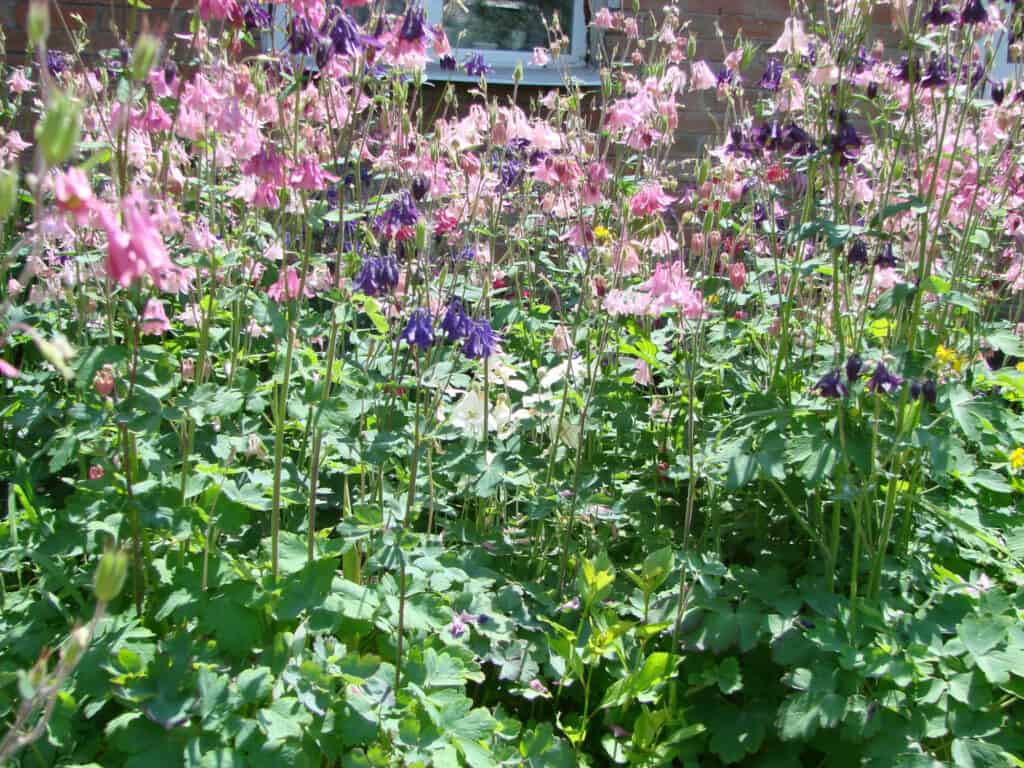
These wildflowers grow to be about 2 to 3 feet tall in the Pacific Northwest.
©Michiru13/Shutterstock.com
The first on our list is the Scarlet Columbine (Aquilegia formosa). This wildflower grows to be about 2 to 3 feet tall, and is open-branched. It has some other common names: the Western Columbine, the Crimson Columbine, and the Red Columbine are its other names. The best time of year to see this flower is anytime from April through August, when it’s in bloom. The Scarlet Columbine is identifiable by its red and yellow spurred petals. It’s a bushy plant that has many different stems. This plant attracts hummingbirds, and the nectar in the Scarlet Columbine was a treat for the Gitxsan and Wet’suwet’en people.
2. Hairy Balsamroot (Balsamorhiza hookeri)

These wildflowers are in full bloom from April until July.
Also known as Hooker’s Balsamroot, this Pacific Northwest wildflower bears sunflower-like flowers at the end of the stem. They are wide, yellow flowers with many petals. The actual flower is about 2 to 3 inches wide. Their stems are leafless and are anywhere from 4 to 12 inches long, and they spur out of a woody taproot. The best time to see them in bloom is from April until July. Hairy Balsamroot is named for William Jackson Hooker, the Director of Kew Gardens and the founder of “Journal of Botany”.
3. Elegant Mariposa Lily (Calochortus elegans)
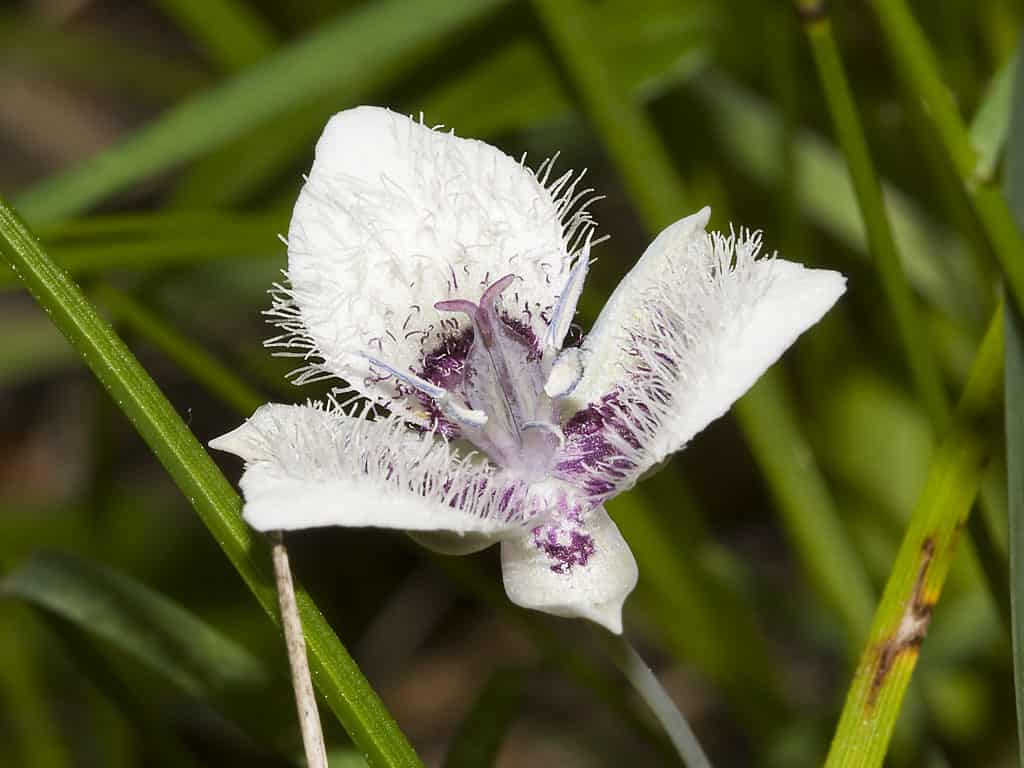
The Elegant Mariposa Lily prefers grassy hillside environments.
The Elegant Mariposa Lily is a small plant that is identifiable by its clustered white and purple flowers. The bunch is shorter than the leaf that sticks out over it. The narrow stems on this wildflower are bent. It tends to be about eight inches tall or less. You’ll want to catch this flower from May through July, when you can see its beautiful white and purple flowers in full bloom.
4. Yellow Mariposa Lily (Calochortus luteus)
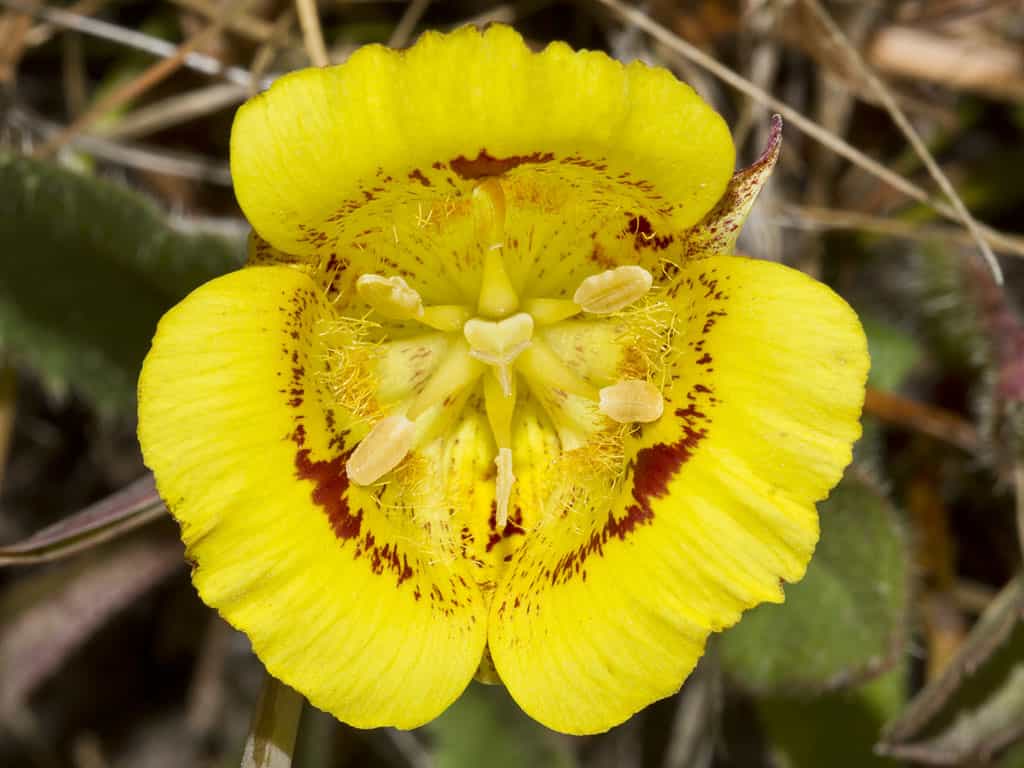
The Yellow Mariposa LIly is a perennial wildflower.
This flower is easy to identify–the Yellow Mariposa Lily has a large yellow flower at the end of the stem, but there are only about 1-4 petals on top with red flashes in the middle. They’re tall though, reaching up to 20 inches in height. You’ll know it’s a Yellow Mariposa Lily as well because the petals are bell-shaped, wider at the top and more narrow as it reaches the base. See them anytime from April til July when they’re in bloom!
5. Common Camass (Camassia quamash)
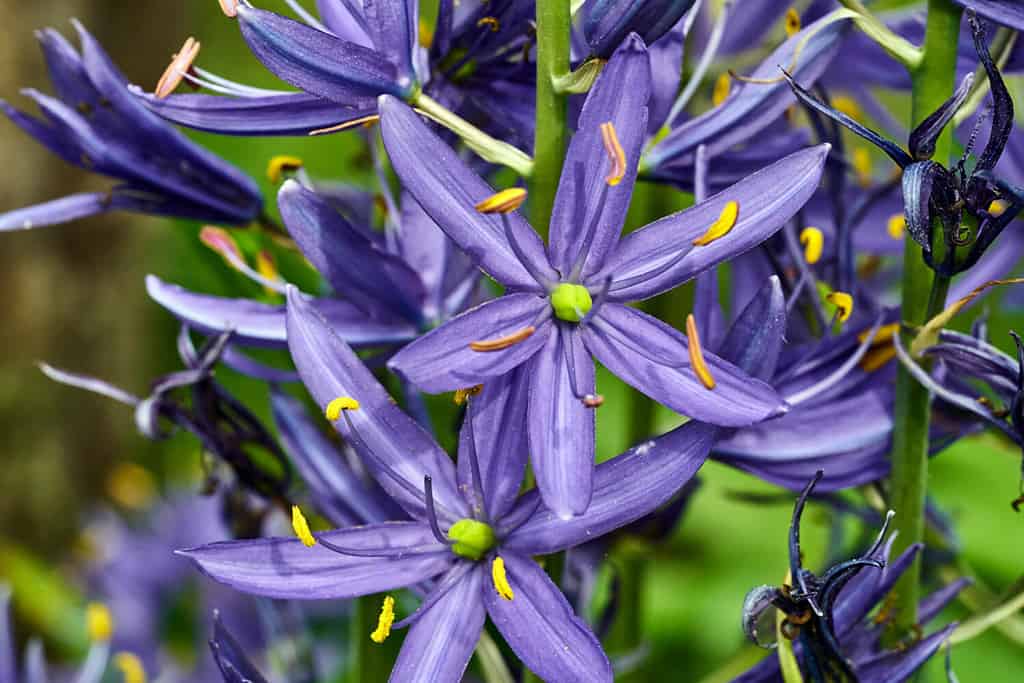
©Jonas Vegele/Shutterstock.com
Also known as the Swamp Sego, the Common Camass is another elegant wildflower found throughout the United States’ Pacific Northwest. They can be identified by their blue and violet flowers that have violet stems with a yellow tip coming out of the center. They have bright green leaves near their base in narrow clusters. Additionally, they can grow to be anywhere from 1 to 3 feet tall. Native Americans would pit roast the bulbs and mix them with other leaves. This process yielded a sweet syrup for them to use. The Common Camass is also an incredibly frequent wildflower–they will sometimes cover an entire meadow! The best time to see these stunning wildflowers is from April until June.
6. Fireweed (Chamerion angustifolium ssp. angustifolium)
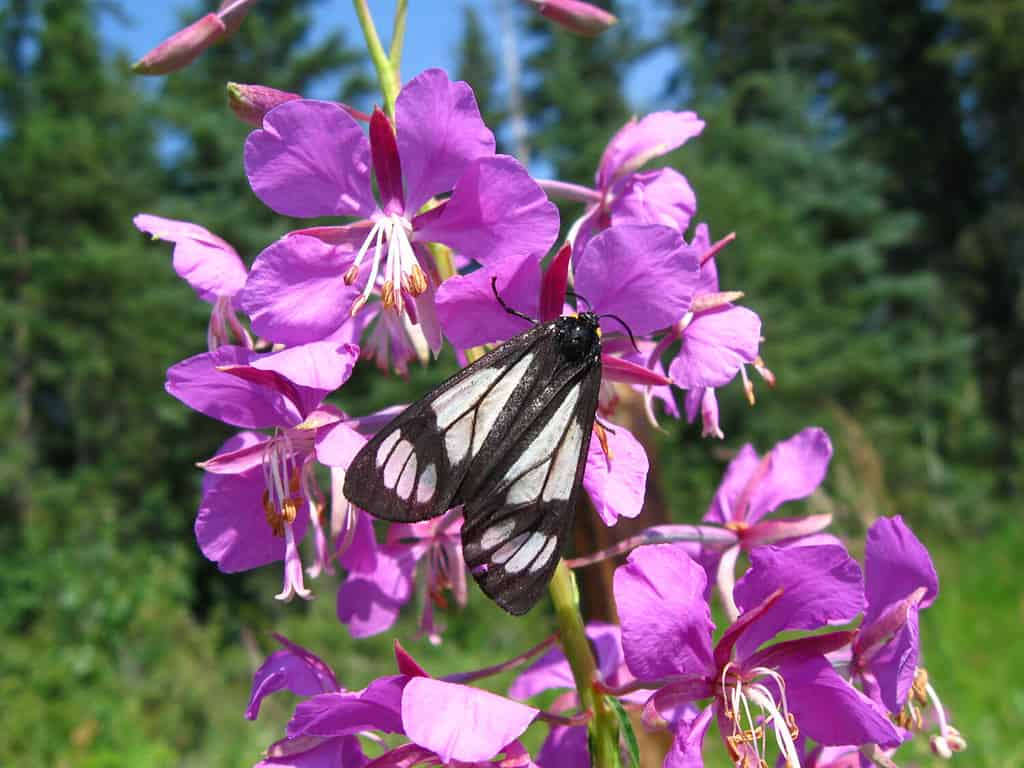
Fireweed is also commonly referred to as Narrow-leaf Fireweed.
©Tiffany K/Shutterstock.com
Fireweed, Narrow-leaf Fireweed, and Willow Herb–all of these names identify this sun-loving wildflower found in the Pacific Northwest. These wildflowers can grow to be 3 to 5 feet tall, towering over other flora. Their stems are usually a crimson, reddish color, that have alternating leaves and are topped by an arrangement of purple, white, and pink flowers. These flowers have four petals that measure a mere one inch across. The best time to see Fireweed is from June to September. This wildflower’s height is hard to miss!
7. Pipsissewa (Chimaphila umbellata)
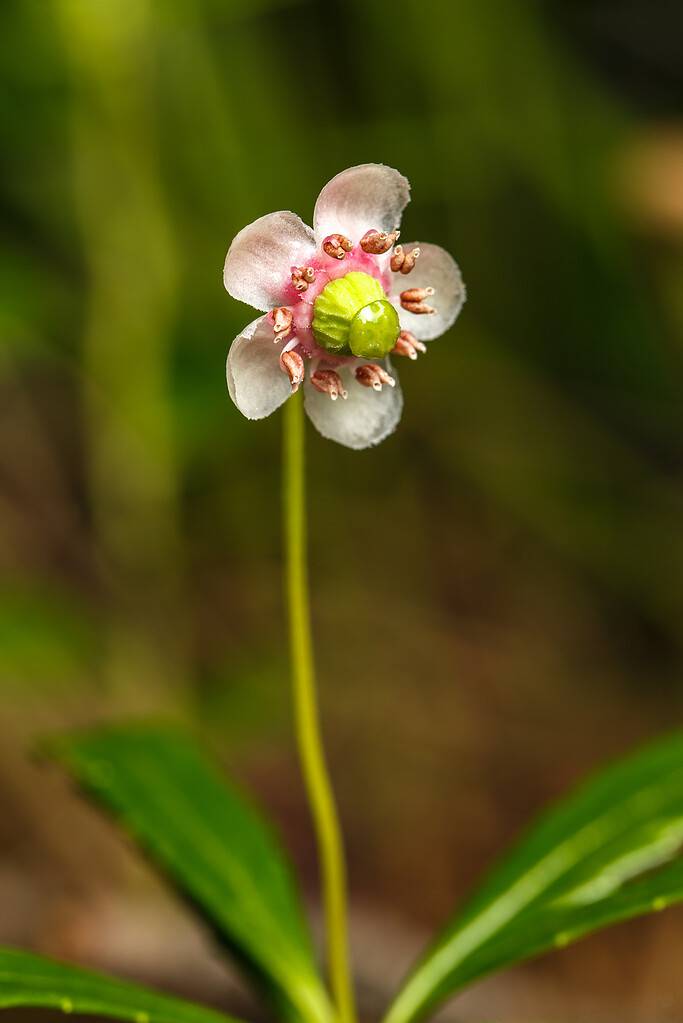
The Pipsissewa wildflower are a perennial wildflower.
©Seregraff/iStock via Getty Images
The Pipsissewa wildflower is a short, four-inch tall wildflower that is found throughout the Pacific Northwest. You can only really find these flowers in July and August. They are identifiable by their evergreen leaves around the stems, and its white and pink flowers that are at the end of the stem. Pipsissewa usually has five petals, with small, stem-like clusters growing out of the petal base in groups of two.
8. Farewell To Spring (Clarkia amoena)
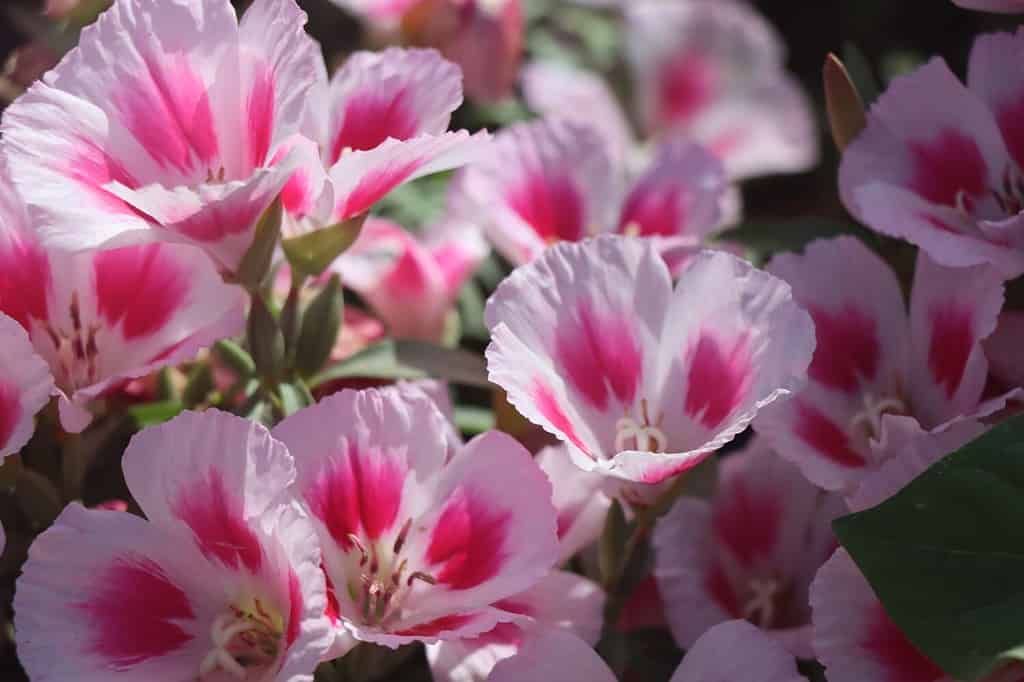
The Farewell To Spring is an annual wildflower.
©Avakov/Shutterstock.com
The Farewell To Spring wildflower is an annual wildflower–meaning, it grows, blossoms, and dies within a year’s time. It’s a farewell to spring and a hello to summer wildflower: the best time to see this wildflower is in June, July, and August. When you see this flower during the summer, you’ll marvel at its cup-shaped white, pink, and purple flowers. It grows to be about 1 to 3 feet and has narrow leaves along its stem. Fun fact: the genus name (the first part of the scientific name) is named for William Clark of Lewis and Clark fame. These two explorers led an expedition throughout the Northwest in the early 1800s.
9. Mountain Lady’s Slipper (Cypripedium montanum)
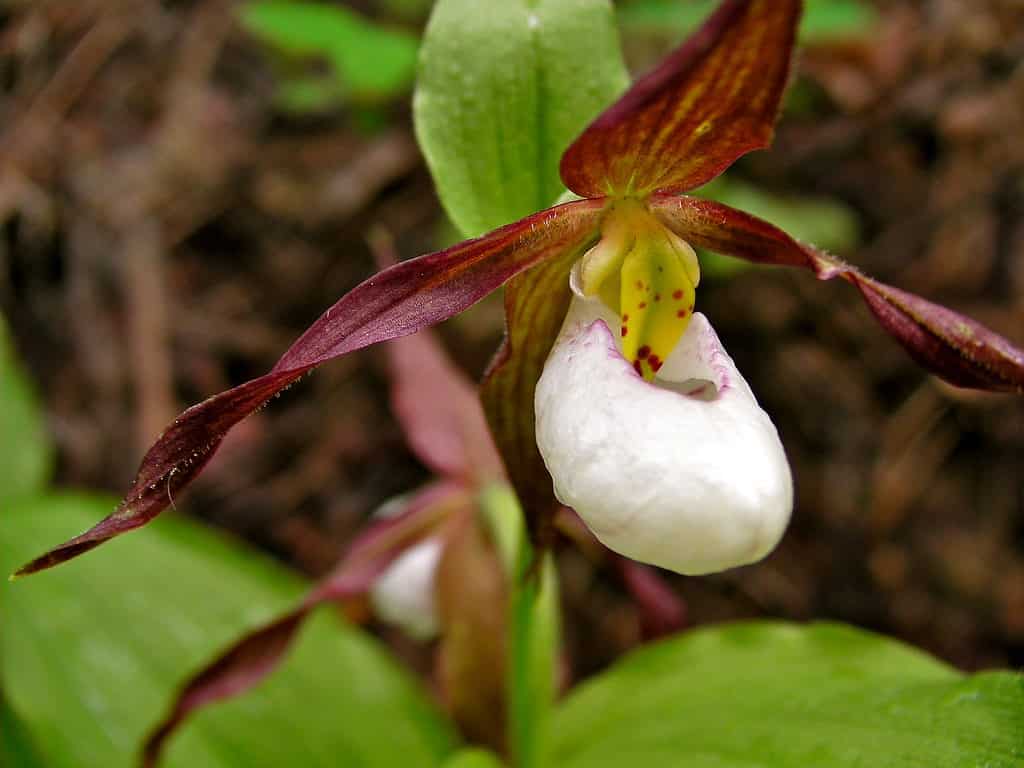
The Mountain Lady’s Slipper wildflower is a mamber of the orchid family.
©Rosalee de la Forêt, CC BY-SA 3.0 <https://creativecommons.org/licenses/by-sa/3.0>, via Wikimedia Commons – Original / License
The Mountain Lady’s Slipper wildflower is one of the most unique-looking flowers on this list. These members of the orchid family are identifiable by their distinctive flowers at the top of a stem cluster. The flower is a white bulb surrounded by 1 to 3 flowers growing outward from the “slipper”. In bloom, they are purple, white, slightly reddish, and green, with a yellow leaf in the middle of the flower. They can grow to be about 2 feet tall, and are in bloom from February all the way until September.
10. Giant Hellebore (Epipactis gigantea)
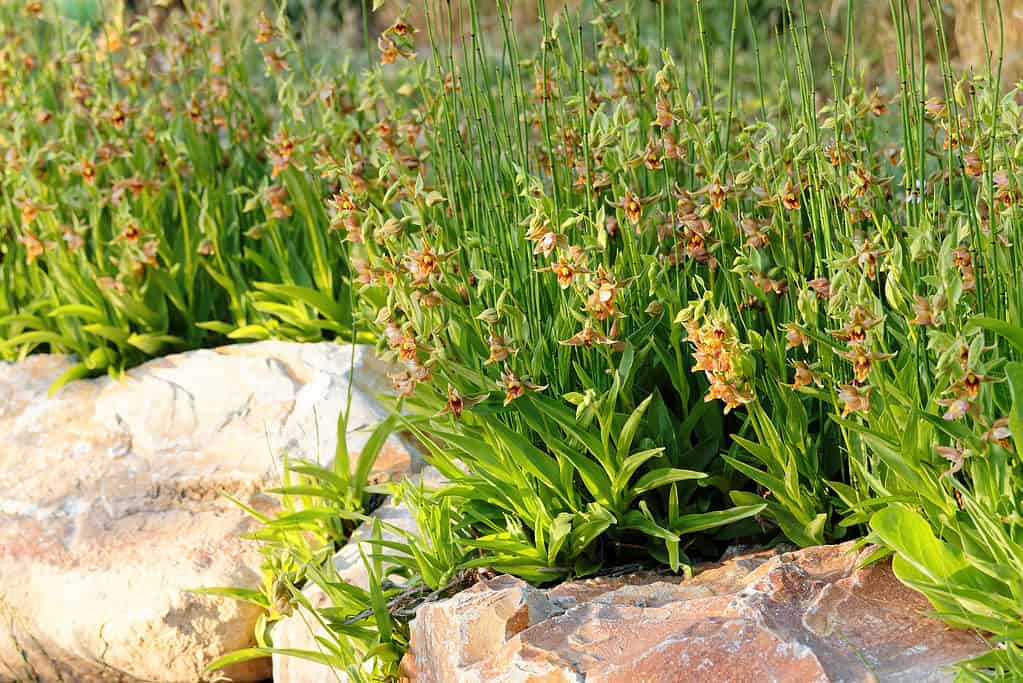
The Giant Hellebore is also often referred to as the Chatterbox Orchid.
©Wirestock/iStock via Getty Images
Another member of the orchid family, the Giant Hellebore is a multi-color wildflower that lives throughout the Pacific Northwest. From March until August, this 4.5-foot-tall wildflower is in bloom. You can identify a Giant Hellebore wildflower by its height, but also its flower–a single, symmetrical flower tops a cluster of stems that has a green-brown color, with wisps of pink in its petals. In full bloom, you may even see orange, yellow, and purple highlighting it as well. The Giant Hellebore has another name: the Chatterbox Orchid. When the flower is touched, the lower part of the flower may move, appearing as if it’s a mouth talking.
11. Tall Cottongrass (Eriophorum angustifolium)
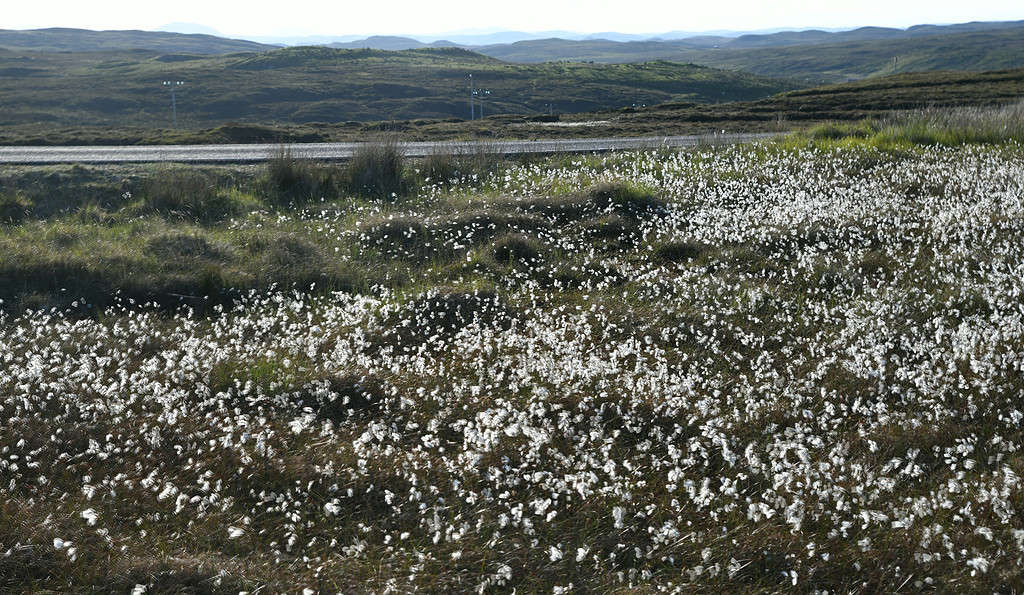
Tall Cottongrass’ scientific name comes from the Greek words
erion, meaning wool, and
phoros,meaning bearing.
©Rini Kools/iStock via Getty Images
Another wildflower that lives in the Pacific Northwest is the Tall Cottongrass. This wildflower is also hard to miss–the flower is missing perianth, or its petals. Instead, at the top of the group of stems are 2 to 8 white, cottony heads that grow in a cluster. These heads that appear to be cotton are actually the petals of smaller, more minuscule flowers. Tall Cottongrass is identifiable by the white tops and green stems with a brownish hue throughout. They tend to be 3 feet tall and are blooming from April until June.
12. Yellow Dogtooth Violet (Erythronium grandiflorum)

The Yellow Dogtooth Violet often grows in open woods and meadow edges.
©Sandra Hosking/iStock via Getty Images
The Yellow Dogtooth Violet oftentimes blooms as the snow melts. It brings with it signs of spring and summer–the best time to see this radiant, bright-yellow wildflower is from April until July, when it is in full bloom. They grow up to 18 inches tall and are commonly found in the woods and in open meadows. Their yellow flowers are hopeful, bringing the joy of spring with them as they bloom. These wildflowers are identifiable by their thick, tall stems that have 2 to 3 basal leaves that hang off the stem. The bright yellow flower at the top typically has 1 to 5 petals, with red, white, or orange anthers in the middle. Yellow Dogtooth Violet wildflowers are very common, often growing in large patches throughout the Pacific Northwest.
13. Common Woolly Sunflower (Eriophyllum lanatum)
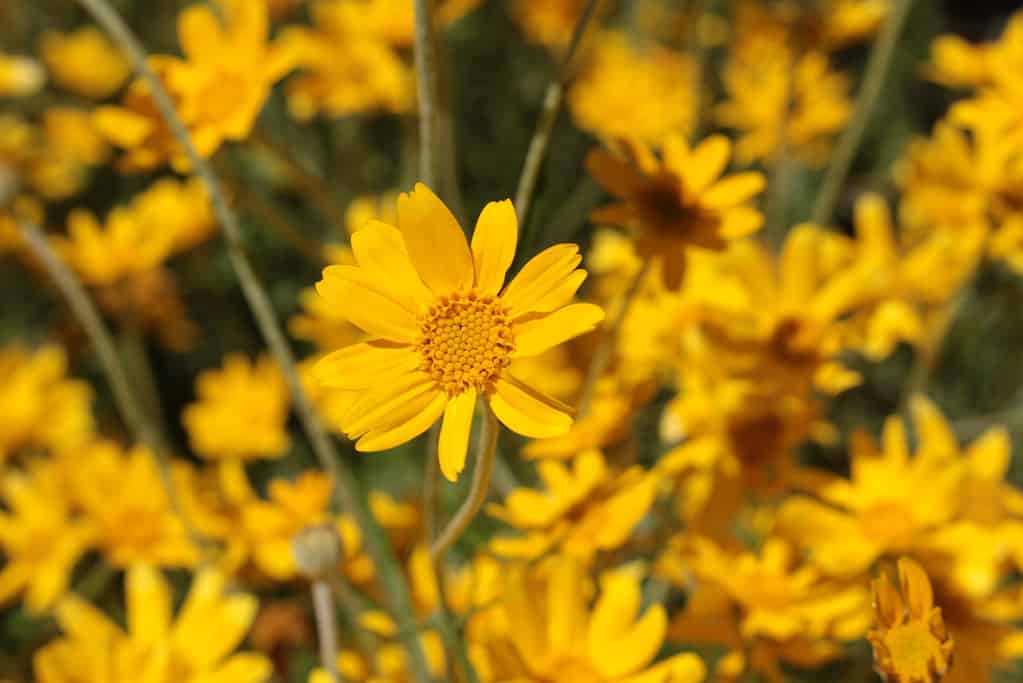
These sunflower-like wildflowers are incredibly common throughout the region.
©RukiMedia/ via Getty Images
This wildflower is very common throughout the Pacific Northwest, often along the sides of roads and in drier areas. While they can reach up to 40 inches in height, they are often shorter. It is a very easy-to-sight wildflower, because of the sheer amount of them that can be found throughout the region. They are identifiable by their yellow, sunflower-like flowers that top their long stems that have many branches. On these branches grow white, woolly leaves. The Common Woolly Sunflower is in full bloom from April until September. Fun fact: they have the nickname Oregon Sunshine because it lights up the regions it typically grows in.
14. White Avalanche-lily (Erythronium montanum)

Avalanch Lillies are one of the first wildflowers to grow out of the melting snow in the Pacific Northwest.
©Joseph Dreimiller/iStock via Getty Images
Another wildflower that grows after the snow begins to melt, the White Avalanche-lily is a beautiful, chalky flower that grows in alpine and subalpine forests and meadows. From June until August, this wildflower is in bloom and will take over full meadows. The flower that grows along the scape usually has about six white petals with a dot of yellow in the center. They grow to be about 14 inches tall.
15. California Gold Poppy (Eschscholzia californica)

The California Gold Poppy is an incredibly common and popular wildflower.
©alybaba/Shutterstock.com
One of the most popular wildflowers out there, the California Gold Poppy is often used in wildflower bunches and assortments, as they are found in such high volumes. They vary in color, typically from orange to yellow, and the flowers only open on sunny days. At the base of the petal is a deep orange color. They can often be found in full bloom from February until October, in large, open, grassy areas. Finally, they often grow to be about two feet tall. Fun fact about this wildflower: they can be found in 30 different states, but are native to the Mojave Desert, as well as coastal Oregon and Washington.
16. Yellow Missionbells (Fritillaria pudica)
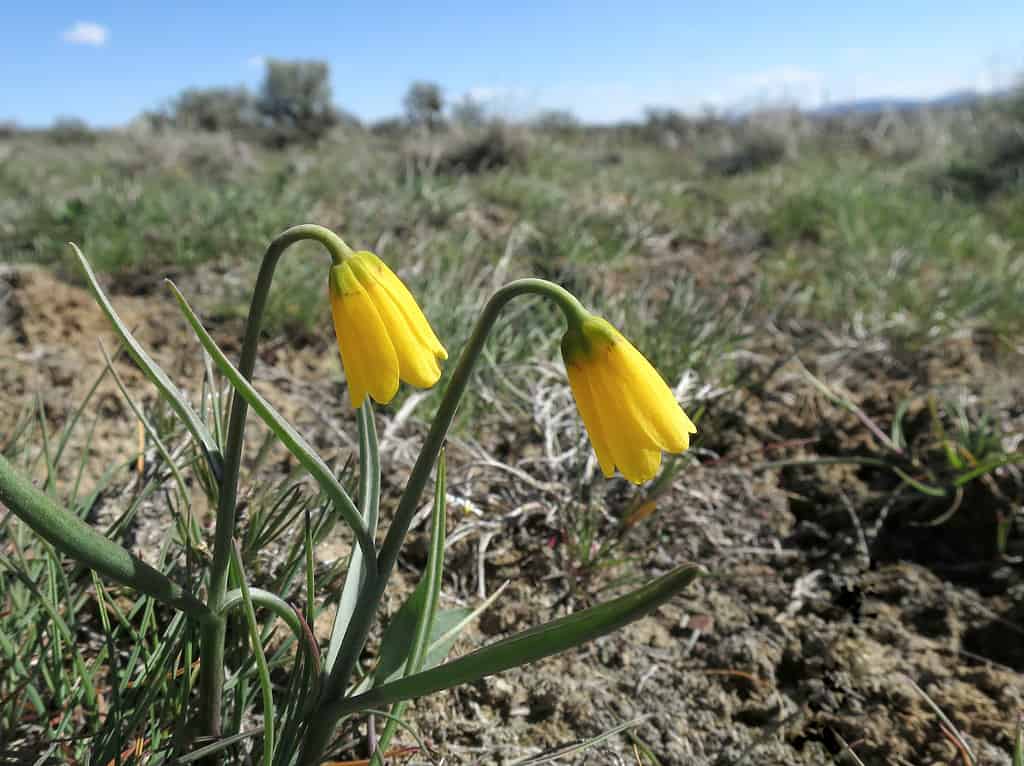
Yellow Missionbells get their name from their bell-shaped flowers.
©randimal/iStock via Getty Images
From March until June, Yellow Missionbells are in full bloom. These perennial wildflowers are about one foot tall with a yellow, bell-shaped flower hanging from the top. It only has one flower usually at the top of the stem, and the green stem typically has little to no leaves. However, there are sometimes leaves subtending the flower. As the wildflower ages, the flower will fade to a red or purplish color.
17. Mountain Iris (Iris douglasiana)
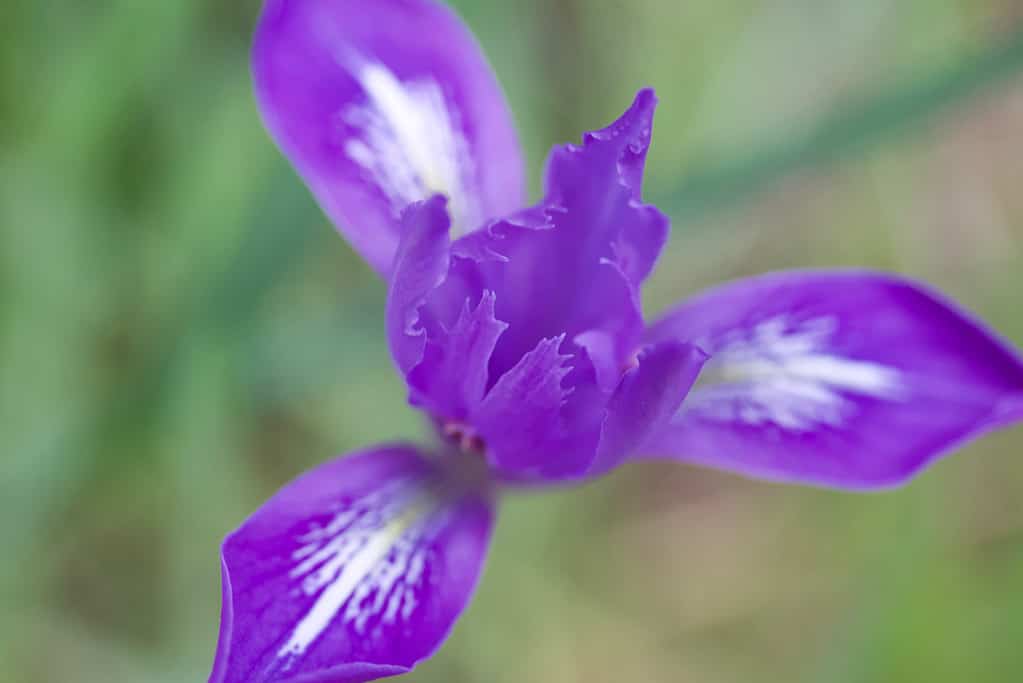
The Mountain Iris is identifiable by its purple leaves with a white burst in the middle.
©Weriset Photos/iStock via Getty Images
A member of the Iris family, the Mountain Iris is a common wildflower throughout the Redwood region. It grows in the coastal regions from Santa Barbara, California, all the way up to Coos County, Oregon. When the Mountain Iris is in full bloom from March through June, its flower often has a blue and purplish color, although this varies. Sometimes, the flower color can range from yellow to reddish purple. The Mountain Iris will grow to be about two feet tall and have dark evergreen leaves that grow out of the rhizome.
18. Coastal Tidytips (Layia platyglossa)
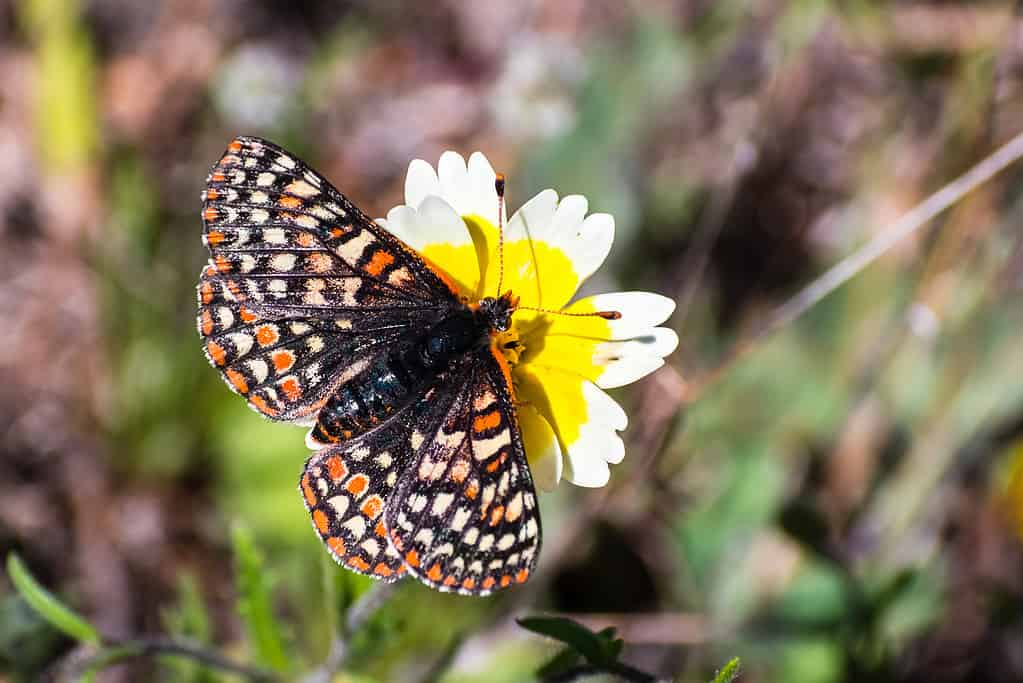
These wildflowers are found in grassy, coastal areas and are identifaible by deep yellow petals with white tips.
©Sundry Photography/Shutterstock.com
Coastal Tidytips are prostrate wildflowers–their stems grow along the ground. They can grow up to 28 inches long. From the branches grow light-green leaves, on which the flowers lie. These flowers have a similar appearance to that of a daisy flower. The petals of this wildflower have white tips and dark yellow down the rest of the petals. Coastal Tidytips are best to be seen from February through July. Birds are a big fan of the seeds that come from this Pacific Northwest wildflower.
19. Wild Tiger Lily (Lilium columbianum)
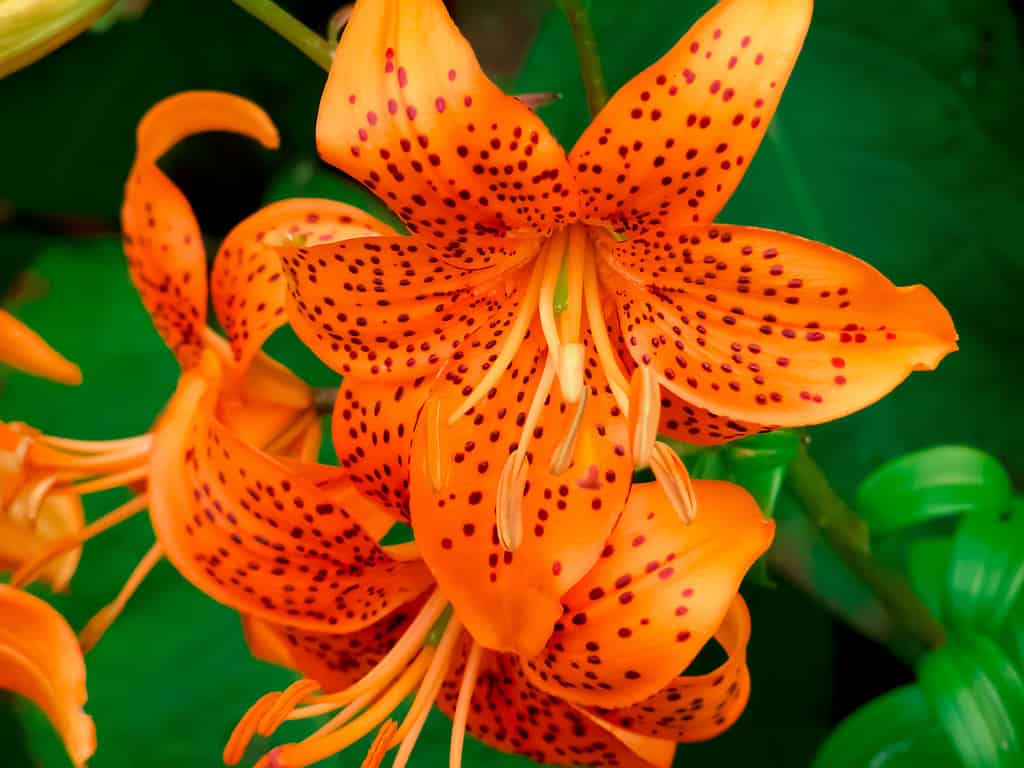
The Wild
Tiger
Lily is also called the Oregon Lily as its commonly found throughout the region.
©Ana-Maria Oprisoreanu/iStock via Getty Images
The Wild Tiger Lily is another incredibly popular wildflower. It’s often replanted in home gardens because of their unique appearance. The stems on this plant are leafy and can get up to almost six feet in height! In exceptional conditions, the Wild Tiger Lily will have almost 12 or more light-orange flowers topping its stem. These flowers have reddish, maroon spots all over the petals. From May through September, the Wild Tiger Lily is in full bloom, beautifully lighting up the Pacific Northwest.
20. Miniature Annual Lupine (Lupinus bicolor)
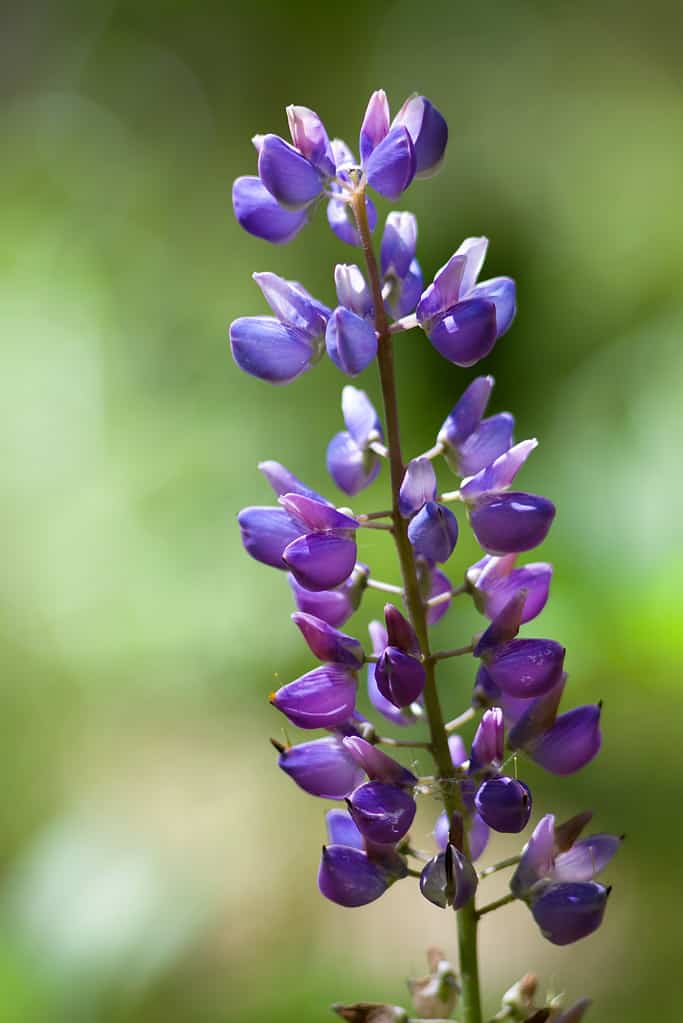
The Miniature Annual Lupine is a wildflower that often grows during the early summer months.
©grannyogrimm/iStock via Getty Images
This 16-inch-tall annual is a staple throughout the Pacific Northwest. It’s clustered stem is covered in many white, purplish flowers in whorls. It’s stem is greenish and hairy. This wildflower is a member of the pea family Fabaceae. The most ancient lupine flower is estimated to be about 10,000 years old. Catch this beautiful wildflower from May through June, when it’s the most blue and violet.
21. Meadow Lupine (Lupinus polyphyllus)

The Meadow Lupine grows along streams and meadows, preferring moist and wet places.
©Gert-Jan van Vliet/iStock via Getty Images
This staggering wildflower clocks in at an astonishing 5 feet tall! Found in full bloom only during May, the Meadow Lupine prefers wet and moist environments. It’s identifiable by it’s purple, pink, and blue blooming flowers, and its incredible height. It has deep green leaves on its unbranched stem and has the violet-blue pea flowers growing along its stem. The Meadow Lupine is one of the tallest of its species, as it averages anywhere from 3 to 5 feet in height. You can’t miss it!
22. American Skunkcabbage (Lysichiton americanus)
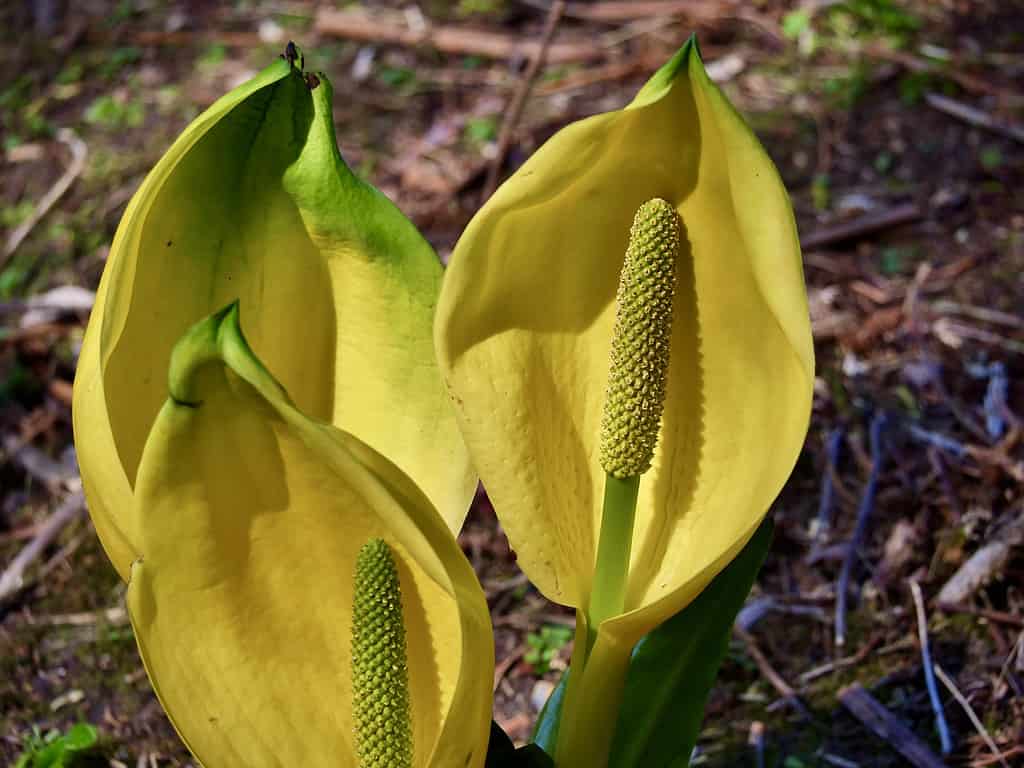
The American Skunkcabbage is incredibly unique in its appearence.
©yujie chen/iStock via Getty Images
Also referred to as the Swamp Lantern wildflower, this perennial is like no other in terms of appearance. It has a remarkably unusual flower: a group of yellow and green florets all combine together and open on one side, showcasing a continuation of the stem covered in seeds. Best seen during the early to mid-spring season (February through May), this 5-foot tall wildflower is sure to be one of the more interesting looking wildflowers on this list. Fun fact: it’s called the American Skunkcabbage due to the smell of the sap that it produces. Also, Native Americans would bake this flower to eat during the winter.
23. Mountain Pride (Penstemon newberryi)

This wildflower prefers high-elevatoin rocky environments.
The Mountain Pride wildflower is one often seen lighting up roadsides throughout the West and Pacific Northwest. Its red, pink, and purplish flowers grow from its leafy stem. Usually, all the flowers are facing or turned towards one side altogether. They can grow to be about a foot tall and are best seen during the summer months, from May til August. They prefer rocky places.
24. Spreading Phlox (Phlox diffusa)
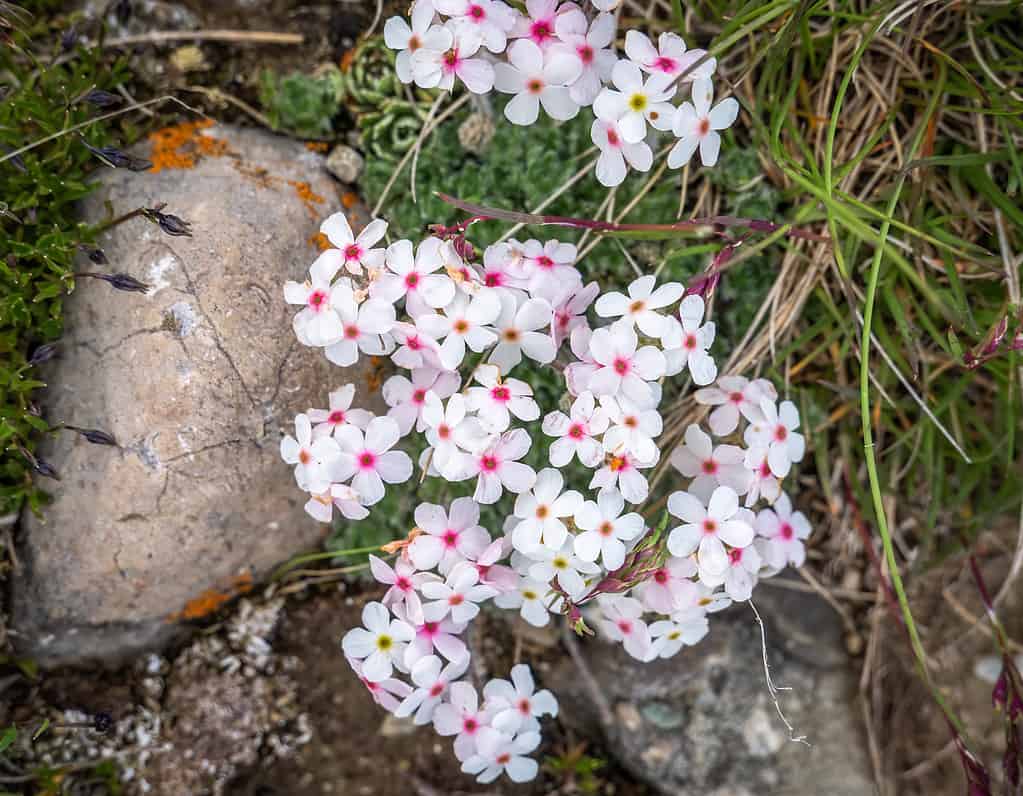
The Spreading Phlox are found all over the Pacific Northwest.
©Cristi Croitoru/iStock via Getty Images
These star-shaped flowers are high in volume throughout the Pacific Northwest. The Spreading Phlox wildflower has beautiful white, purple, and pink flowers that top its leafy stems. The mats of this flower cover the ground and are covered in yellow-green leaves. They are needle-like but far from spiky. They are often covered by the sheer amount of flowers that adorn this wildflower, as the flowers will typically cover the rest of the plant. The Spreading Phlox is in full bloom from March until August and is only about six inches tall at its max.
25. Pink Mountain Heather (Phyllodoce empetriformis)

The Pink Mountain Heather is another Pacific Northwest wildflower that has bell-shaped flowers.
©Wirestock/iStock via Getty Images
The Pink Mountain Heather is another wildflower that grows wide mats at its base. They are covered in evergreen leaves and foliage that, unlike the Spreading Phlox, are in fact needle-like and spiky. At the top of the flower are pink flowers–these are identifiable because the flower resembles a bell. They grow in clusters and top the stem and are pink and purple in color. From June through August, you can see these beautiful wildflowers grow up to 20 inches tall.
26. California Buttercup (Ranunculus californicus)

These wildflowers are identifiable by their deep yellow flowers that can be pointed out from far away.
©Sundry Photography/iStock via Getty Images
The California Buttercup is a member of the Ranunulaceae family, or the buttercup family. These shrub-like wildflowers grow frequently throughout the Pacific Northwest, and can be identified by the yellow, multi-petal flower cup. The California Buttercup grows flat on the ground, and the flower stem grows up. They can get to be upwards of two feet long and are in bloom from January until August.
27. Pacific Rhododendron (Rhododendron macrophyllum)
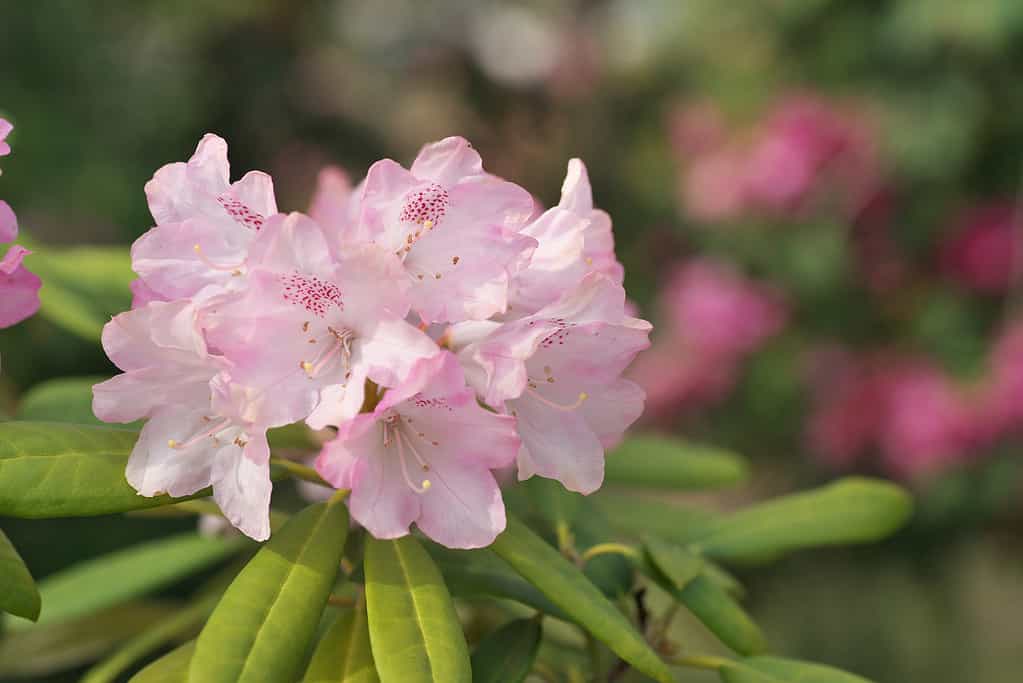
The Pacific Rhododendron is a very common wildflower in the Pacific Northwest’s coastal woods.
©igaguri_1/iStock via Getty Images
Clocking in at anywhere from 5 to 15 feet in height, the Pacific Rhododendron is one of the tallest wildflowers on this list. It’s an evergreen shrub that has large leaf whorls around it that support pink and purple bell-shaped flowers. It’s one of the more common wildflowers on this list, and it’s most abundant in Oregon. From April through July, you can see the Pacific Rhododendron growing in large amounts through the coastal woods.
28. Western Turkeybeard (Xerophyllum tenax)

The Western Turkeybeard can grow upwards of six feet tall.
©stevelenzphoto/iStock via Getty Images
Finally, the last wildflower on this list is the Western Turkeybeard. This wildflower has a multitude of nicknames: Bear Lily, Elk Grass, Squaw Grass, and Pine Lily are a few of its other names. While flowering, the Western Turkeybeard can grow up to six feet in height. A flower stalk grows out over the evergreen leaves that grow around its stem. The flower stalk holds a clustered group of white flowers that are best seen from March until August. Fun Fact about the Western Turkeybeard: Native Americans would use the leaves from this wildflower to weave different baskets and garments!
Thank you for reading! Have some feedback for us? Contact the AZ Animals editorial team.








